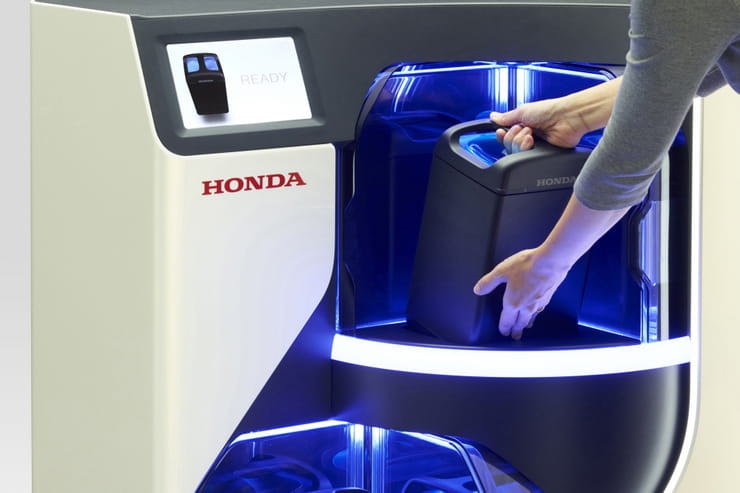Honda, Yamaha, KTM and Piaggio join forces on battery bikes
By Ben Purvis
Motorcycle Journalist
01.03.2021
Four of the world’s biggest motorcycle makers have signed a letter of intent to create a ‘Swappable Batteries Consortium for Motorcycles and Light Electric Vehicles’ to hammer out the specs for a standardised battery that can be used in electric bikes from all their ranges.
The idea is one that’s been around for a while. Instead of frantically searching for a charging point and waiting hours to replenish a dying battery in your electric motorcycle of the future, you simply pull into a filling station and swap the dead pack for a freshly charged one, keeping you on the move with a process that’s quicker than filling a petrol tank. The filling station then recharges your old one to add to its stock.
But to work, it’s essential that bikes across multiple brands use the same battery packs. Basically, it’s the same thinking that led to the creation of standardised batteries – AA cells, AAA cells etc – for consumer electronics.
The consortium is intended to establish a set of standards in terms of size, capacity, chemistry and connections to make sure a Piaggio battery will slot straight into a Honda, Yamaha or KTM, and vice versa.
The idea is one that is already well developed in many respects. Honda’s PCX Electric scooter, which is already in production and available in some parts of the world, uses a battery that the firm intends to be able to be swapped with a variety of other upcoming vehicles, including the EV Cub and Benly e. Honda also envisages the same unit being used in mowers, ATVs and anything else that currently uses a small petrol engine.
Yamaha has followed a similar idea with its PES and PED electric concept bikes, and also the EC-05 scooter which is built for the firm by Gogoro. Gogoro already has a battery swap network up and running in Taiwan with some 2000 ‘GoStation’ points where you can change to a fresh battery pack, proving the idea works.
The benefits go beyond the mere convenience of quick refuelling. Without the hassle and time impact of having to recharge an electric bike, the demand for a long range from a battery pack is greatly diminished. That means bike designers will be able to develop models around smaller, lighter batteries, reducing overall weight and size. That leads to a virtuous cycle, as the smaller, lighter bike wastes less energy lugging an oversized, overweight battery around.
The Consortium is intended to start work in May this year, but comes on the heels of another cooperative effort, this time between the ‘Big Four’ Japanese brands – Honda, Yamaha, Kawasaki and Suzuki – which all investigated the same subject last year, initiating a trial battery swap system at and around Osaka University. The new Consortium shows that European brands are also now in the mix.
About the new joint effort, Noriaki Abe, Managing Officer, Motorcycle Operations at Honda said: “The worldwide electrification effort to reduce CO2 on a global scale is accelerating, especially in Europe. For the widespread adoption of electric motorcycles, problems such as travel distance and charging times need to be addressed, and swappable batteries are a promising solution. Considering customer convenience, standardization of swappable batteries and wide adoption of battery systems is vital, which is why the four member manufacturers agreed to form the Consortium.
“Honda views improving the customers’ usage environment as an area to explore cooperation with other manufacturers, while bringing better products and services to customers through competition. Honda will work hard on both fronts to be the ‘chosen’ manufacturer for customer mobility.”
Yamaha’s Takuya Kinoshita, Chief General Manager of Motorcycle Business Operations, adds: “I believe the creation of this Consortium holds great significance not just for Europe but the world as we move towards establishing standards for swappable batteries for light electric vehicles. I’m confident that through work like this, the technical specs and standards that currently differ by regional characteristics or the state of the industry in different markets will be unified, and, in the future, will help lead towards maximizing the merits of electric power for customers on a global level.”
Standardised labels for all batteries
Meanwhile, electric bike riders who need to recharge their built-in batteries are about to get a boost in Europe thanks to a new system of harmonised labelling for electric vehicles and charging stations.
The labels will be introduced on 20th March on all new electric vehicles, including mopeds, motorcycles, trikes and quads, with matching ones on charging stations to help owners identify the right charger for them. Although the UK has left the EU since the legislation to implement the new labelling was drawn up, we’re still currently aligned with the EU on it, and it makes a lot of sense for the same labels to be adopted here.
Under the scheme, the type of charger and voltage will be identified by a hexagonal symbol and a letter, each denoting a different type of charger and socket. For instance a ‘C’ in the hexagon means a ‘Type 2’ charger/socket with up to 480V.
Details of the labelling system can be found here: https://fuel-identifiers.eu/
Share on social media:

